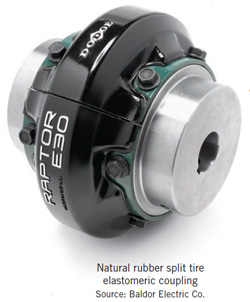Take (and keep) the load off bearings
Element material selection is a critical component in the design process for any elastomeric coupling. This is no different for axially split tire elements. Some manufacturers use a high-load-capacity polyurethane bonded to metal clamp rings. At first glance, this material would appear to be a wise choice; polyurethane is a very strong material, and the primary function of a coupling is to transmit torque.
However, several other factors need to be considered before you choose an elastomeric material. In addition to transmitting torque, couplings should also allow for misalignment and vibration damping, and they should be able to absorb energy from shock loads, which could damage driving or driven equipment. Natural rubber has been used in the industry for decades, as it offers a number of performance benefits when compared with a urethane.
The most important component of an axially split element tire coupling is the bond between the elastomeric material and metal clamp rings. If designed properly, this bond is actually stronger than the bond between the internal molecules of the elastomer itself. Through the use of finite element methods, engineers have unlocked the key to a high-integrity bond. A high-integrity bond involves increasing the surface area in the most critical regions, allowing for more-uniform pressure, which results in an improved fatigue life. Though polyurethane has a higher torque carrying capability, the geometric design and high-integrity bond provide a natural rubber solution that not only matches the torque ratings of polyurethane designs, but also provides longer coupling life.
Although urethane couplings can handle pure angular or pure parallel misalignment, their capabilities are greatly diminished in applications with combined angular and parallel misalignment. The softer natural rubber compound used in some elastomeric couplings has a low bending stiffness, allowing for this combination of misalignment while keeping the reactionary effects at a minimum. Bending stiffness is a material’s resistance against deformation created by misalignment. This means an elastomeric coupling must compensate for misalignment, which can cause additional load on other pieces of equipment, such as the bearings in motors, pumps, compressors, and gearboxes. Using a natural rubber compound with a lower bending stiffness means less resultant load on the equipment’s bearings and ultimately longer connected equipment life.
A natural rubber element offers less torsional stiffness than a polyurethane design, resulting in greater shock load and vibration damping capabilities. A material’s ability to absorb energy generated from shock loading and vibration is known as damping. This factor can be critical when attempting to protect the equipment that the coupling is joining. The side effect of damping is hysteresis.
Hysteresis is the internal buildup of heat within the elastomer due to the absorption of energy through mechanical power transference. This is typically seen in elastomeric couplings and is miniscule in continuously running applications. Hysteresis becomes an issue on applications dealing with frequent starts and stops, high torsional vibration, or shock loading.

These types of applications generate a lot of heat through internal friction, and there are two ways to dissipate the heat. The first is to shut down the application, which is usually inconvenient, undesirable, and potentially expensive. The second involves choosing a material with a higher thermal conductivity. This type of material can dissipate heat at a rate equal to or better than the rate of internal heat buildup. Natural rubber has a high thermal conductivity – better than that of other polyurethane materials. This allows the coupling to continuously run under severe conditions longer than urethane designs.
Natural rubber’s excellent ability to dissipate heat is also the reason it is better suited for use in applications with VFDs. VFD wave forms produce tiny continuous oscillations that are seen by the coupling. These continuous oscillations create the same internal buildup of heat that shock loading creates that must dissipate to prevent failure. This used to be a much larger issue for elastomeric couplings with older VFD technology. As VFD technology has improved, the pulsations of the waveforms have decreased. However, many users still have scars from using elastomeric couplings with VFDs. Some users avoid elastomeric couplings altogether, opting to use only metallic couplings. Today’s improved VFD technology and the use of a natural rubber element makes elastomeric couplings a viable option for use with VFDs.
The physical properties of natural rubber combined with an optimizedcross-sectional geometry and a high integrity bond make natural rubber the obvious choice for split tire elastomeric couplings. Natural rubber’s resistance to tear and abrasion as well as its bonding capabilities, vibration damping capabilities, and ability to dissipate heat allow for a durable and long-lasting coupling.
CR. https://www.plantservices.com/articles/2017/














